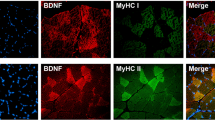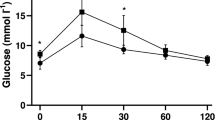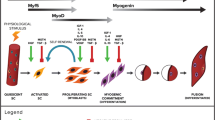Abstract
Oestrogen receptor β (ERβ) is expressed in human skeletal muscle tissue. In the present study, we have developed an immunohistochemical method to reveal if ERβ is located within the muscle fibres as well as within capillaries. Skeletal muscle biopsies were obtained from m. quadriceps femoris vastus lateralis in four healthy young subjects. Immunohistochemical triple staining was applied to transverse sections of paraffin-wax-embedded tissue. The basement membrane of muscle fibres and capillaries was identified by using an antibody to collagen IV, endothelial cells using an antibody to CD34 and ERβ using a corresponding antibody. The ERβ-positive (ERβ+) nuclei were located within the muscle fibre defined by the localisation of collagen IV. ERβ+ nuclei were also, for the first time, found in endothelial cells of capillaries in skeletal muscle tissue. Quantification was performed on transverse cryostat sections after performing a double staining (collagen IV and ERβ). It was shown that 24% of the ERβ+ nuclei were located within capillaries, and 76% were located within muscle fibres. In conclusion, ERβ in human skeletal muscle tissue is expressed not only in the muscle fibres themselves, but also within the capillary endothelial cells. This observation might improve understanding of the physiological role of oestrogen and its receptor.
Similar content being viewed by others
Avoid common mistakes on your manuscript.
Introduction
Recently, it was demonstrated for the first time that the oestrogen receptor β (ERβ) is expressed in human skeletal muscle tissue with a nuclear localisation (Wiik et al. 2003). However, with the applied immunohistochemical protocol in the above-mentioned study, it was not possible to determine whether some of the receptors were localised in endothelial cells of the capillaries, or if all receptors were localised in the nuclei of the muscle fibres.
Oestrogen has been shown to improve endothelial function in women (Farhat et al. 1996), and increase endothelial proliferation in rat heart muscle (Jesmin et al. 2002). Furthermore, endothelial cells have been identified as a target for oestrogen, and oestrogen receptors are present in various vascular beds (Kim-Schulze et al. 1996). For example, ERβ has been found in human endothelial cells from umbilical vein, coronary artery, myometrium and endometrium (Crithchley et al. 2001; Gargett et al. 2002; Taylor and Al-Azzawi 2000). However, very little is known about the expression of oestrogen receptors and their role in the vascular system of skeletal muscle tissue. Thus, the specific aim of the present study was to develop an immunohistochemical method by which it is possible to differentiate between ERβ-localisation in muscle fibres and/or in capillaries within skeletal muscle tissue. The application of such a method may lead to improved understanding of the physiological role of oestrogen and its receptors in muscle tissue. It may also be a valuable tool for studying the localisation of other proteins in human muscle tissue.
Materials and methods
Muscle biopsies
Muscle biopsies from four young healthy adults (two women and two men), mean age 25 years, were obtained at rest from the m. quadriceps femoris vastus lateralis using the percutaneous needle technique (Bergström 1962). One portion of each biopsy was frozen in isopentane, pre-cooled with liquid nitrogen and stored at −80°C until analysis. The remaining part of each biopsy was processed and paraffin embedded after fixation in 4% paraformaldehyde, in 0.1 M phosphate buffer (pH 7.2) for 3 h.
The Committee of Ethics at the Karolinska Institute approved the study. All subjects gave their informed consent prior to their inclusion in the study.
Triple-fluorescence staining procedure on transverse paraffin sections (for details see Table 1)
Sections of 3-μm thickness from the muscle biopsies were deparaffinised, rehydrated and processed in citrate buffer pH 6.0 for antigen retrieval by microwave treatment. Endogenous peroxidase activity was quenched using aqueous hydrogen peroxide (0.77%). The basement membrane, ERβ, endothelial cells and immune cells were detected with an antiserum to collagen IV, ERβ 503 antiserum, CD34 antibody and a CD45 antibody (leucocyte common antigen), respectively. Dilutions were made in phosphate-buffered saline (PBS) containing 1% bovine serum albumin (BSA) and 0.3% Triton X-100. Two different triple-staining protocols were applied on consecutive sections. One section was stained by a combination of the collagen IV, ERβ and CD34 antibodies. On the consecutive section, the collagen IV, ERβ and CD45 antibodies were used in combination. The sections were incubated overnight at 4°C and thereafter extensively rinsed in PBS followed by a secondary antibody mixture, all diluted in the same buffer as above, and thereafter again extensively rinsed in PBS. The sections were mounted in Vectashield (Vector Laboratories, Burlingame, CA, USA) and evaluated with a fluorescence microscope (Olympus BX 60, Tokyo, Japan; digital camera, Sony CDK-500, Tokyo, Japan) equipped with the appropriate filters. As a negative control, the three antibodies were replaced with PBS containing 1% BSA.
Double-staining procedure on transverse sections from frozen tissue (For details see Table 1)
Cryostat sections of 5-μm thickness from muscle biopsies were fixed in cold methanol followed by cold acetone. Endogenous peroxidase activity was quenched using aqueous hydrogen peroxide (0.77%). To block non-specific binding, the sections were treated with normal swine serum (Dako A/S, Glostrup, Denmark) for 20 min and diluted 1:20 in Tris-buffered saline (TBS) containing 1% BSA. The basement membrane was detected with an antibody to collagen IV (Kalluri 2003) diluted in the same buffer as above, followed by a secondary antibody. Thereafter, the sections were incubated with avidin–biotin-peroxidase complex (Vectastain Elite ABC-kit, Vector Laboratories). As a negative control, the two antibodies were replaced with TBS containing 1% BSA. The same ERβ 503 antiserum, pre-absorbed, was also used in a previous study and proved to be negative (Wiik et al. 2003).
Further investigations were carried out to show the absence or presence and nature of immune cells in the tissue. Two consecutive transverse cryostat sections were probed, the first using an antibody to CD3 for T cells, and the second using an antibody to CD11b for T cells, granulocytes, monocytes and natural killer (NK) cells. The protocol used Vectastain ABC Elite reagents in a similar staining procedure to that above, except for the chromogen.
Separate sections were stained with the ERβ antibody and haematoxylin, to determine histologically if the ERβ immunoreactivity was only located in the nuclei.
Blood smear staining
A peripheral blood smear was also stained with the ERβ antibody to investigate whether erythrocytes contain ERβ.
Quantification of relative proportions
The double-stained cryostat sections were chosen for the quantification of relative proportions, as their colour is stable with time. The fluorescence labelling of the paraffin sections has a tendency to fade. The proportion of ERβ+ nuclei in muscle fibres and capillaries, respectively, was calculated by the total number of ERβ+ nuclei in an area of a transverse cryostat section and the number of ERβ+ nuclei within the capillaries. For the quantification of the immunoreactive structures, an image analysis system was used (Leica Microsystems, Sollentuna, Sweden). Sections were viewed at a magnification of 500× and readings taken until an area containing a total of approximately 50 muscle fibres had been included for the following variables: number of muscle fibres (A), total number ERβ+ nuclei (B) and the number of ERβ+ nuclei within capillaries (C). Three calculations were conducted from these measurements as follows: (1) the proportion of ERβ+ nuclei located in capillaries (C/B×100), (2) the proportion of ERβ+ nuclei located in muscle fibres ((B − C)/B×100) and (3) the proportion of ERβ+ nuclei in capillaries per muscle fibre (C/A). The ERβ+ nuclei that were neither located within muscle fibres nor capillaries were less than 1% of the total number of ERβ+ nuclei and therefore not included.
Results
Qualitative analysis
Using ERβ immunohistochemistry and haematoxylin histology, it was revealed that ERβ only had a nuclear localisation, confirming the previous findings of Wiik et al. (2003).
Immunohistochemical evaluation revealed that the ERβ+ nuclei were located within the muscle fibre as supported by the collagen IV+ basement membrane staining. ERβ+ nuclei were also, for the first time, found to be located in the capillary endothelial cells in human skeletal muscle tissue (based on the concomitant staining of collagen IV and CD34) (Fig. 1a). ERβ+ nuclei were also seen in endothelial cells of larger blood vessels. Since these vessels were too few, no calculations, however, were performed to determine the proportion that was ERβ+.
Immunohistochemical triple staining of two consecutive paraffin-embedded human muscle tissue sections. a The green colour marks ERβ+ nuclei. The star indicates a localisation within a muscle fibre, while the white arrows point at endothelial nuclei. The blue colour marks the collagen IV+ basement membrane of the muscle fibres and capillaries. Endothelial cells (CD34) are demonstrated by pink colour where the pink arrows point at capillary endothelial cells. Co-localisations of ERβ and CD34 appear in yellow. b A marker for inflammatory cells (CD45) is used instead of CD34 and demonstrated by pink colour (no CD45+ cells within this area). c Demonstrates a positive area of CD45 (pink). b and c ERβ and collagen IV are visualised with the same colours as in (a). Bars = 1 μm
The consecutive section showed ERβ+ nuclei both within the muscle fibre and within the capillaries, while no CD45+ immune cells could be identified (Fig. 1b). In Fig. 1c, a CD45+/ERβ+ cell is shown in order to illustrate that sometimes such double staining was seen.
The frequency of CD3+ and/or CD11b+ immune cells in the cryostat sections and CD45+ immune cells in the paraffin sections was shown to be less than 0.05 cells per muscle fibre in each case.
ERβ was not shown in erythrocytes as stained in a blood smear.
Quantitative analysis
ERβ+ nuclei were shown in muscle fibres and capillaries, respectively (Fig. 2a; red colour). The basement membrane of the capillaries was identified by collagen IV antibodies (Fig. 2a; grey/blue colour). The negative control showed no staining of ERβ and collagen IV (Fig. 2b).
a Immunohistochemical double staining of two different areas of a frozen human muscle tissue section demonstrating ERβ (red) and collagen IV (blue/grey) of the muscle fibres and capillaries. An ERβ+ nuclei within the muscle fibre is indicated by a star. Insets show ERβ+ nuclei in the capillaries. Bars = 10 μm. b Negative control for the staining demonstrated in (a). Bars = 50 μm
Quantification of the four muscle samples revealed that 24% (median) (range 16–26%) of the ERβ+ nuclei were located within the capillaries and as interpreted from the qualitative analyses the vast majority of these were endothelial cell nuclei. Since extremely few ERβ+ nuclei were found in the interstitium, that is, outside both the muscle fibre and the capillary compartments, we estimated that 76% (74–84%) of the ERβ+ nuclei were located within the muscle fibres. It was also found that approximately 0.5 capillaries per muscle fibre were ERβ+.
Discussion
This is the first study demonstrating the expression of ERβ in nuclei of both muscle fibres and capillaries in human skeletal muscle tissue. The study was carried out by the development of immunohistochemical double-/triple-staining methods suitable for this particular tissue type. The collagen IV staining of the basement membrane associated with muscle cells made the identification of ERβ+ nuclei within the muscle fibres easier. The capillary basement membrane was also identified with greater certainty using this collagen staining. The ERβ+ nuclei within the capillaries were interpreted as being those of endothelial cells based on the criteria below.
The study excluded one potential source of error in the interpretation of the double-stained biopsies (ERβ and collagen IV). This was that certain immune cells could be misclassified as endothelial cells, since immune cells also were found to be ERβ+. However, in a study by Malm et al. (2000), and unpublished data from the same author, it was shown that immune cells, such as granulocytes, monocytes, T cells and macrophages, were in the range of 0.02–0.05 per muscle fibre in resting skeletal muscle biopsies from healthy individuals. Our own data from the present study reveal such a low number of CD3+, CD11b+ and CD45+ immune cells (less than 0.05 cells per muscle fibre). However, we found approximately 0.5 ERβ+ capillaries per muscle fibre, that is, more than ten times the immune cells. Thus, it is most likely that only a small number of the ERβ+ nuclei within capillaries were immune cells. In the present study, the erythrocytes as stained in a blood smear were negative for ERβ and can thus be excluded as a possible source of error. Therefore, in our view, the ERβ+ capillary nuclei in our set of biopsies do represent endothelial cell nuclei. This was also confirmed in the present study by the two triple staining investigations, where ERβ+ nuclei were shown not only within muscle fibres but also within endothelial cells together with negative staining for immune cells (Fig. 2a, b).
The relative distribution of ERβ between muscle fibres and capillaries may be crucial in the physiological response to ER-mediated transcriptional activity, and thereby a determinant of the biological effects. However, at this stage, one may only speculate upon the physiological role of ERβ in skeletal muscle tissue. For instance, the gene for vascular endothelial growth factor (VEGF) has a functional oestrogen response element. VEGF is known to enhance both myogenesis and angiogenesis (Arcic et al. 2004; Gustafsson and Kraus 2001). Such ER-mediated effects may favour muscle tissue repair and also muscle adaptation to physical training.
The application of these double-/triple-staining methods may in future studies be a tool helping to give us better understanding of the physiological role of oestrogen and its receptors in muscle tissue, as well as its possible association with angiogenesis. The current staining protocols may also be a tool for investigating the localisation of other molecules in muscle tissue.
In conclusion, ERβ is expressed in human skeletal muscle tissue not only in the muscle fibres themselves, but also in the capillary endothelial cells.
References
Arcic N, Zacchigna S, Zentilin L, Ramirez-Correa G, Pattarini L, Salvi A, Sinagra G, Giacca M (2004) Vascular endothelial growth factor stimulates skeletal muscle regeneration in vivo. Mol Ther 10:844–854
Bergström J (1962) Muscle electrolytes in man. Scand J Clin Lab Invest Suppl 68:1–110
Crithchley HOD, Brenner RM, Henderson TA, Williams K, Nayak NR, Slayden OD, Millar MR, Saunders PTK (2001) Estrogen receptor beta, but not estrogen receptor alfa, is present in the vascular endothelium of the human and nonhuman primate endometrium. J Clin Endocrinol Metab 86:1370–1378
Farhat MY, Lavigne MC, Ramwell PW (1996) The vascular protective effects estrogen. FASEB J 10:615–624
Gargett CE, Zaitseva M, Bucak K, Chu S, Fuller P J, Rogers PAW (2002) 17 β-estradiol up-regulates vascular endothelial growth factor receptor-2 expression in human myometrial microvascular endothelial cells: Role of estrogen receptor-α and –β. J Clin Endocrinol Metab 87:4341–4349
Gustafsson T, Kraus WE (2001) Exercise-induced angiogenesis-related growth and transcription factors in skeletal muscle, and their modification in muscle pathology. Front Biosci 1:75–89
Jesmin S, Sakuma I, Hattori Y, Kitabatake A (2002) In vivo estrogen manipulations on coronary capillary network and angiogenic molecule expression in middle-aged female rats. Arterioscler Thromb Vasc Biol 22:1591–1597
Kalluri R (2003) Basement membranes: structure, assembly and role in tumour angiogenesis. Nat Rev Cancer 3:422–433
Kim-Schulze S, McGowan KA, Hubchak S et al (1996) Expression of an estrogen receptor by human coronary artery and umbilical vein endothelial cells. Circulation 94:1402–1407
Malm C, Nyberg P, Engström M, Sjödin B, Lenkej R, Ekblom B, Lundberg I (2000) Immunological changes in human skeletal muscle and blood after eccentric exercise and multiple biopsies. J Physiol 529:243–262
Saji S, Jensen EV, Nilsson S, Rylander T, Warner M, Gustafsson JÅ (2000) Estrogen receptors alfa and beta in the rodent mammary gland. Med Sci 97:337–342
Taylor AH, Al-Azzawi F (2000) Immunolocalisation of oestrogen receptor beta in human tissues. J Mol Endocrinol 24:145–155
Wiik A, Glenmark B, Ekman M, Esbjörnsson-Liljedahl M, Johansson O, Bodin K, Enmark E, Jansson E (2003) Oestrogen receptor β is expressed in adult human skeletal muscle both at the mRNA and protein level. Acta Physiol Scand 179:381–387
Acknowledgements
This study was supported by grants from the Swedish National Centre for Research in Sports, Swedish Research Council (14295), Åke Wibergs Stiftelse, Magnus Bergvalls Stiftelse, Centre of Gender-Related Medicine and The Cancer and Allergy Foundation (Cancer och Allergifonden). The authors wish to acknowledge Associate Professor Margaret Warner for providing the ERβ 503 antibody.
Author information
Authors and Affiliations
Corresponding author
Rights and permissions
About this article
Cite this article
Wiik, A., Ekman, M., Morgan, G. et al. Oestrogen receptor β is present in both muscle fibres and endothelial cells within human skeletal muscle tissue. Histochem Cell Biol 124, 161–165 (2005). https://doi.org/10.1007/s00418-005-0030-z
Accepted:
Published:
Issue Date:
DOI: https://doi.org/10.1007/s00418-005-0030-z






